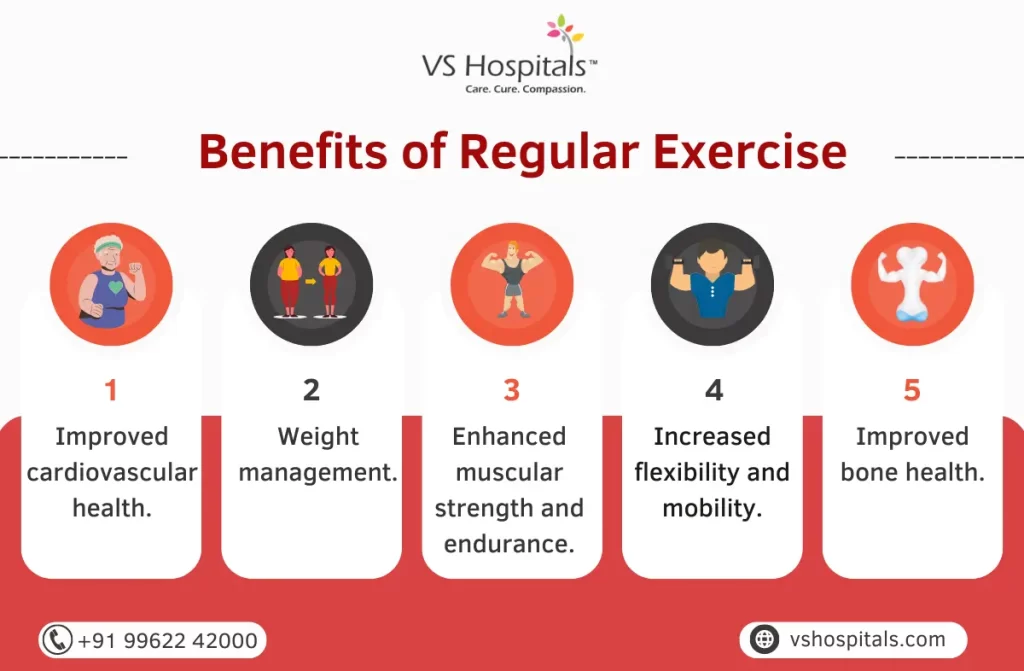Your physical fitness has a big impact on how you feel about yourself, and how much effort your body has to expend in order to keep working. Maintaining physical fitness is essential for overall health and well-being. The benefits of regular exercise and a balanced diet play a vital role in keeping your body strong, reducing the risk of chronic diseases, and improving mental health.
In this article, we will explore the importance of physical fitness and provide practical tips to help you achieve and maintain a healthy body with exercise for body health.
Components of Physical Fitness
To achieve optimal physical fitness, it is important to address the following components:
- Cardiovascular Endurance: Activities that increase heart rate and elevate breathing, such as jogging, swimming, or cycling, improve cardiovascular endurance, enabling your body to sustain physical activity over extended periods.
- Muscular Strength and Endurance: Incorporating resistance training exercises like weightlifting or bodyweight workouts. The benefits of regular exercise aid to build muscle strength and endurance improves overall physical performance and reduces the risk of injury.
- Flexibility: Exercise for body health like stretching exercises, yoga, or Pilates enhance flexibility, promoting joint mobility and preventing muscle stiffness and injuries.
- Balance and Coordination: Engaging in activities like tai chi or yoga improves balance and coordination, reducing the risk of falls and enhancing overall physical stability.

10 Importance of Physical Fitness
These are considered to be the 10 importance of physical fitness.
- Incorporating regular physical activity into your daily routine is the most effective approach to enhancing your physical fitness.
- There’s no need to commit to a full gym membership or attend exercise classes to improve your physical fitness.
- The key to choosing an activity is that you can experience the benefits of regular exercise as it increases your heart rate, and improves your strength and general flexibility.
- Simple activities like walking a few steps, doing some housework or gardening, and climbing the stairs, are all examples of something that can fit quite easily into your routine, but it also increases your physical fitness.
- Activities like taking the elevator, driving the car to the shop at the corner of your street, and spending hours in bed are all things that neither improve your fitness level nor add to the benefits of physical activity.
- Regular physical activity helps to increase heart rate, improving cardiovascular health and reducing the risk of heart disease.
- It enhances muscular strength, making daily tasks easier and improving overall physical performance.
- The 10 importance of physical fitness includes flexibility, increasing the range of motion in joints, and reducing the risk of injury.
- Physical activity releases endorphins, the “feel-good” hormones, which can boost your mood, reduce stress, and improve overall mental well-being.
- It contributes to better overall health, reducing the risk of chronic conditions like obesity, diabetes, and certain cancers, while promoting longevity and a higher quality of life.
Maintaining a Healthy Lifestyle: Beyond Fads and Resolutions
Adopting a healthy lifestyle cannot be treated as a passing trend or a plan for the distant future. It should be a continuous commitment throughout the year, rather than a New Year’s resolution that fades away. Once you embark on an exercise routine, it’s essential to maintain it for life, as discontinuing it would result in a loss of physical fitness, requiring you to start anew.
Without regular exercise, the muscles reduce, and fat takes its place (muscles do not become fat, they merely move over to make more room for it if they aren’t used). It is therefore important that you choose a regime that is going to keep you interested and enjoy the exercise for body health in the long term; each year brings forth a fresh wave of “fitness fads,” but the majority of individuals embrace them only to abandon them within a couple of weeks.
If the idea of following instructions to step up and down on a plastic board doesn’t appeal to you, there are alternative options worth considering. Martial arts, known for their enduring popularity, offer an engaging avenue to improve physical fitness. Additionally, incorporating a team sport into your fitness routine can also provide a rewarding experience while reaping the benefits of physical activity.
Benefits of Regular Exercise
There are various benefits of regular exercise. Some of them include:
- Improved Cardiovascular Health: Engaging in aerobic exercises such as running, swimming, or cycling strengthens your heart and improves blood circulation, reducing the risk of heart disease and stroke.
- Increased Muscular Strength and Endurance: Strength training exercises, like lifting weights or practicing yoga, build muscle mass and enhance overall strength and endurance. These benefits of physical activity help you perform daily activities more efficiently.
- Weight Management: Combining regular exercise with a healthy diet helps maintain a healthy weight by burning calories and increasing metabolism.
- Enhanced Mental Well-Being: Physical activity releases endorphins, also known as “feel-good” hormones, which elevate mood, reduce stress, and combat anxiety and depression.
- Improved Bone Density: Weight-bearing exercises such as walking, jogging, and dancing can help strengthen bones, reducing the risk of osteoporosis and fractures.
Tips for Achieving and Maintaining Physical Fitness
You can follow the below-mentioned as it adds to the benefits of regular exercise. These include:
- Set Realistic Goals: Establish achievable fitness goals that are specific, measurable, attainable, relevant, and time-bound (SMART). This tracks your progress and stays motivated.
- Create a Balanced Exercise Routine: Incorporate a variety of aerobic exercises, strength training, flexibility exercises, and balance activities into your weekly workout routine to address all components of physical fitness.
- Prioritize Consistency: Consistency is key to reap the benefits of physical fitness. Aim for sessions for regular exercise rather than sporadic intense workouts. Start with manageable time frames and gradually increase intensity and duration.
- Get Enough Rest and Recovery: Allow your body to rest and recover between workouts to prevent overexertion and reduce the risk of injuries. Strive to achieve 7-8 hours of restful sleep each night.
Conclusion
To conclude, you should always remember that physical activity performed every day is the key to fitness, and that is what is important. Also, improving your physical fitness can enhance the benefits of regular exercise besides helping you to feel more positive about yourself.
Read also Neck Pain Treatment in Chennai.





